Yuxiao Liu
GR-2: A Generative Video-Language-Action Model with Web-Scale Knowledge for Robot Manipulation
Oct 08, 2024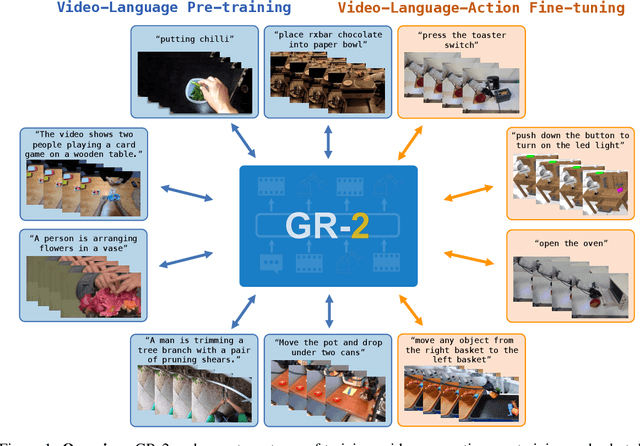
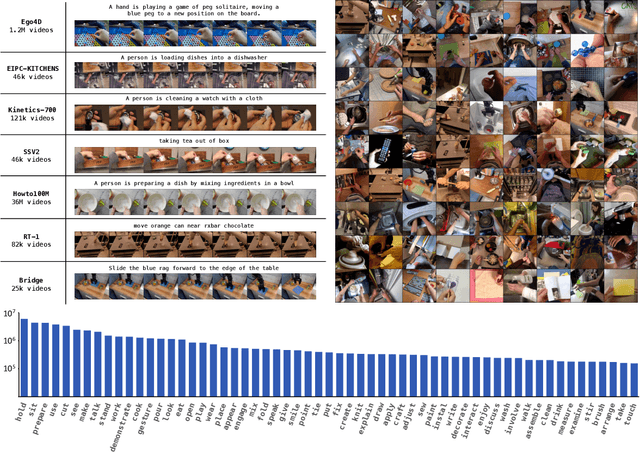
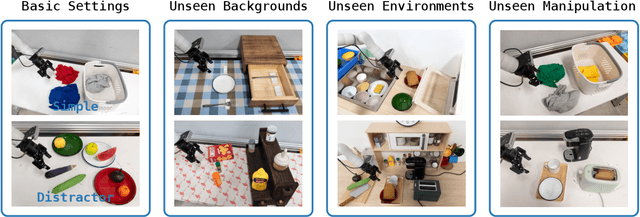
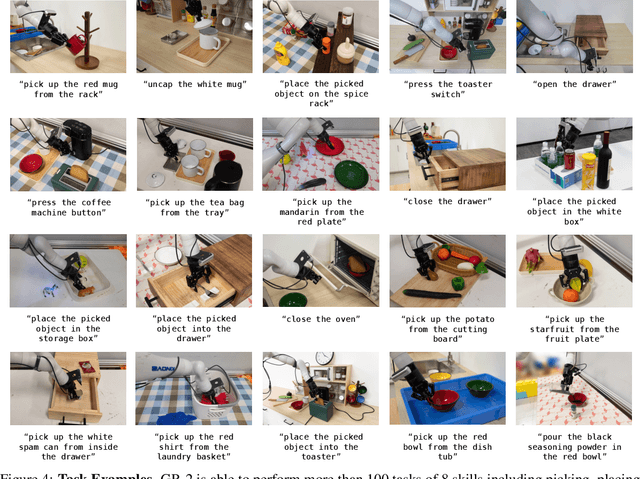
Abstract:We present GR-2, a state-of-the-art generalist robot agent for versatile and generalizable robot manipulation. GR-2 is first pre-trained on a vast number of Internet videos to capture the dynamics of the world. This large-scale pre-training, involving 38 million video clips and over 50 billion tokens, equips GR-2 with the ability to generalize across a wide range of robotic tasks and environments during subsequent policy learning. Following this, GR-2 is fine-tuned for both video generation and action prediction using robot trajectories. It exhibits impressive multi-task learning capabilities, achieving an average success rate of 97.7% across more than 100 tasks. Moreover, GR-2 demonstrates exceptional generalization to new, previously unseen scenarios, including novel backgrounds, environments, objects, and tasks. Notably, GR-2 scales effectively with model size, underscoring its potential for continued growth and application. Project page: \url{https://gr2-manipulation.github.io}.
A Progressive Single-Modality to Multi-Modality Classification Framework for Alzheimer's Disease Sub-type Diagnosis
Jul 26, 2024
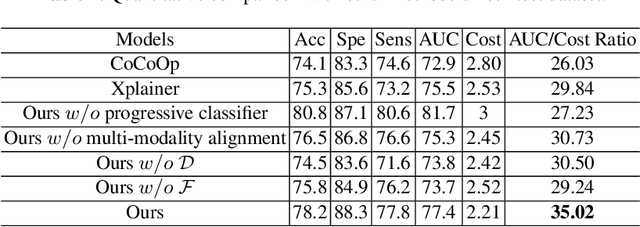


Abstract:The current clinical diagnosis framework of Alzheimer's disease (AD) involves multiple modalities acquired from multiple diagnosis stages, each with distinct usage and cost. Previous AD diagnosis research has predominantly focused on how to directly fuse multiple modalities for an end-to-end one-stage diagnosis, which practically requires a high cost in data acquisition. Moreover, a significant part of these methods diagnose AD without considering clinical guideline and cannot offer accurate sub-type diagnosis. In this paper, by exploring inter-correlation among multiple modalities, we propose a novel progressive AD sub-type diagnosis framework, aiming to give diagnosis results based on easier-to-access modalities in earlier low-cost stages, instead of modalities from all stages. Specifically, first, we design 1) a text disentanglement network for better processing tabular data collected in the initial stage, and 2) a modality fusion module for fusing multi-modality features separately. Second, we align features from modalities acquired in earlier low-cost stage(s) with later high-cost stage(s) to give accurate diagnosis without actual modality acquisition in later-stage(s) for saving cost. Furthermore, we follow the clinical guideline to align features at each stage for achieving sub-type diagnosis. Third, we leverage a progressive classifier that can progressively include additional acquired modalities (if needed) for diagnosis, to achieve the balance between diagnosis cost and diagnosis performance. We evaluate our proposed framework on large diverse public and in-home datasets (8280 in total) and achieve superior performance over state-of-the-art methods. Our codes will be released after the acceptance.
Potential of Multimodal Large Language Models for Data Mining of Medical Images and Free-text Reports
Jul 08, 2024



Abstract:Medical images and radiology reports are crucial for diagnosing medical conditions, highlighting the importance of quantitative analysis for clinical decision-making. However, the diversity and cross-source heterogeneity of these data challenge the generalizability of current data-mining methods. Multimodal large language models (MLLMs) have recently transformed many domains, significantly affecting the medical field. Notably, Gemini-Vision-series (Gemini) and GPT-4-series (GPT-4) models have epitomized a paradigm shift in Artificial General Intelligence (AGI) for computer vision, showcasing their potential in the biomedical domain. In this study, we evaluated the performance of the Gemini, GPT-4, and 4 popular large models for an exhaustive evaluation across 14 medical imaging datasets, including 5 medical imaging categories (dermatology, radiology, dentistry, ophthalmology, and endoscopy), and 3 radiology report datasets. The investigated tasks encompass disease classification, lesion segmentation, anatomical localization, disease diagnosis, report generation, and lesion detection. Our experimental results demonstrated that Gemini-series models excelled in report generation and lesion detection but faces challenges in disease classification and anatomical localization. Conversely, GPT-series models exhibited proficiency in lesion segmentation and anatomical localization but encountered difficulties in disease diagnosis and lesion detection. Additionally, both the Gemini series and GPT series contain models that have demonstrated commendable generation efficiency. While both models hold promise in reducing physician workload, alleviating pressure on limited healthcare resources, and fostering collaboration between clinical practitioners and artificial intelligence technologies, substantial enhancements and comprehensive validations remain imperative before clinical deployment.
IRASim: Learning Interactive Real-Robot Action Simulators
Jun 20, 2024



Abstract:Scalable robot learning in the real world is limited by the cost and safety issues of real robots. In addition, rolling out robot trajectories in the real world can be time-consuming and labor-intensive. In this paper, we propose to learn an interactive real-robot action simulator as an alternative. We introduce a novel method, IRASim, which leverages the power of generative models to generate extremely realistic videos of a robot arm that executes a given action trajectory, starting from an initial given frame. To validate the effectiveness of our method, we create a new benchmark, IRASim Benchmark, based on three real-robot datasets and perform extensive experiments on the benchmark. Results show that IRASim outperforms all the baseline methods and is more preferable in human evaluations. We hope that IRASim can serve as an effective and scalable approach to enhance robot learning in the real world. To promote research for generative real-robot action simulators, we open-source code, benchmark, and checkpoints at https: //gen-irasim.github.io.
TexVocab: Texture Vocabulary-conditioned Human Avatars
Mar 31, 2024



Abstract:To adequately utilize the available image evidence in multi-view video-based avatar modeling, we propose TexVocab, a novel avatar representation that constructs a texture vocabulary and associates body poses with texture maps for animation. Given multi-view RGB videos, our method initially back-projects all the available images in the training videos to the posed SMPL surface, producing texture maps in the SMPL UV domain. Then we construct pairs of human poses and texture maps to establish a texture vocabulary for encoding dynamic human appearances under various poses. Unlike the commonly used joint-wise manner, we further design a body-part-wise encoding strategy to learn the structural effects of the kinematic chain. Given a driving pose, we query the pose feature hierarchically by decomposing the pose vector into several body parts and interpolating the texture features for synthesizing fine-grained human dynamics. Overall, our method is able to create animatable human avatars with detailed and dynamic appearances from RGB videos, and the experiments show that our method outperforms state-of-the-art approaches. The project page can be found at https://texvocab.github.io/.
CLIP in Medical Imaging: A Comprehensive Survey
Dec 26, 2023



Abstract:Contrastive Language-Image Pre-training (CLIP), a simple yet effective pre-training paradigm, successfully introduces text supervision to vision models. It has shown promising results across various tasks, attributable to its generalizability and interpretability. The use of CLIP has recently gained increasing interest in the medical imaging domain, serving both as a pre-training paradigm for aligning medical vision and language, and as a critical component in diverse clinical tasks. With the aim of facilitating a deeper understanding of this promising direction, this survey offers an in-depth exploration of the CLIP paradigm within the domain of medical imaging, regarding both refined CLIP pre-training and CLIP-driven applications. In this study, We (1) start with a brief introduction to the fundamentals of CLIP methodology. (2) Then, we investigate the adaptation of CLIP pre-training in the medical domain, focusing on how to optimize CLIP given characteristics of medical images and reports. (3) Furthermore, we explore the practical utilization of CLIP pre-trained models in various tasks, including classification, dense prediction, and cross-modal tasks. (4) Finally, we discuss existing limitations of CLIP in the context of medical imaging and propose forward-looking directions to address the demands of medical imaging domain. We expect that this comprehensive survey will provide researchers in the field of medical image analysis with a holistic understanding of the CLIP paradigm and its potential implications. The project page can be found on https://github.com/zhaozh10/Awesome-CLIP-in-Medical-Imaging.
ChatRadio-Valuer: A Chat Large Language Model for Generalizable Radiology Report Generation Based on Multi-institution and Multi-system Data
Oct 10, 2023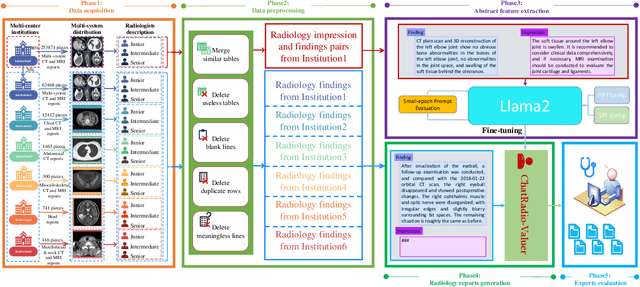
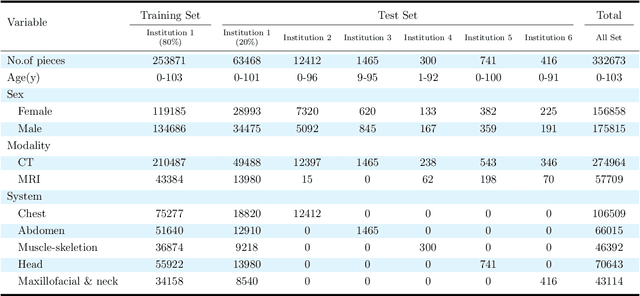
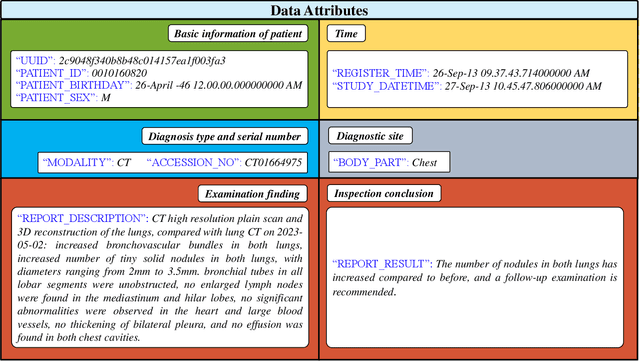
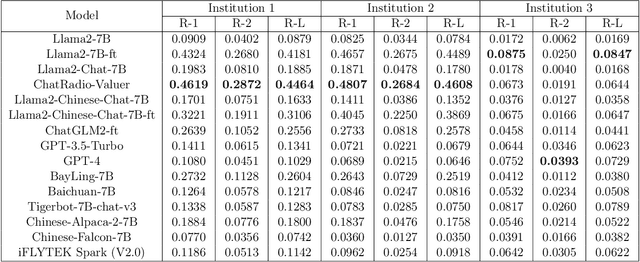
Abstract:Radiology report generation, as a key step in medical image analysis, is critical to the quantitative analysis of clinically informed decision-making levels. However, complex and diverse radiology reports with cross-source heterogeneity pose a huge generalizability challenge to the current methods under massive data volume, mainly because the style and normativity of radiology reports are obviously distinctive among institutions, body regions inspected and radiologists. Recently, the advent of large language models (LLM) offers great potential for recognizing signs of health conditions. To resolve the above problem, we collaborate with the Second Xiangya Hospital in China and propose ChatRadio-Valuer based on the LLM, a tailored model for automatic radiology report generation that learns generalizable representations and provides a basis pattern for model adaptation in sophisticated analysts' cases. Specifically, ChatRadio-Valuer is trained based on the radiology reports from a single institution by means of supervised fine-tuning, and then adapted to disease diagnosis tasks for human multi-system evaluation (i.e., chest, abdomen, muscle-skeleton, head, and maxillofacial $\&$ neck) from six different institutions in clinical-level events. The clinical dataset utilized in this study encompasses a remarkable total of \textbf{332,673} observations. From the comprehensive results on engineering indicators, clinical efficacy and deployment cost metrics, it can be shown that ChatRadio-Valuer consistently outperforms state-of-the-art models, especially ChatGPT (GPT-3.5-Turbo) and GPT-4 et al., in terms of the diseases diagnosis from radiology reports. ChatRadio-Valuer provides an effective avenue to boost model generalization performance and alleviate the annotation workload of experts to enable the promotion of clinical AI applications in radiology reports.
Evaluating Large Language Models for Radiology Natural Language Processing
Jul 27, 2023Abstract:The rise of large language models (LLMs) has marked a pivotal shift in the field of natural language processing (NLP). LLMs have revolutionized a multitude of domains, and they have made a significant impact in the medical field. Large language models are now more abundant than ever, and many of these models exhibit bilingual capabilities, proficient in both English and Chinese. However, a comprehensive evaluation of these models remains to be conducted. This lack of assessment is especially apparent within the context of radiology NLP. This study seeks to bridge this gap by critically evaluating thirty two LLMs in interpreting radiology reports, a crucial component of radiology NLP. Specifically, the ability to derive impressions from radiologic findings is assessed. The outcomes of this evaluation provide key insights into the performance, strengths, and weaknesses of these LLMs, informing their practical applications within the medical domain.
PoseVocab: Learning Joint-structured Pose Embeddings for Human Avatar Modeling
May 14, 2023
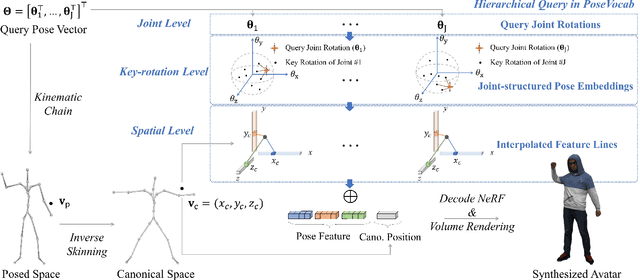

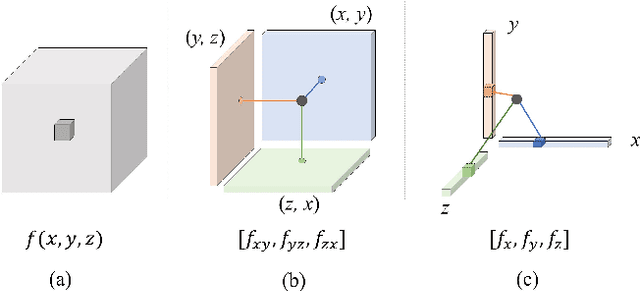
Abstract:Creating pose-driven human avatars is about modeling the mapping from the low-frequency driving pose to high-frequency dynamic human appearances, so an effective pose encoding method that can encode high-fidelity human details is essential to human avatar modeling. To this end, we present PoseVocab, a novel pose encoding method that encourages the network to discover the optimal pose embeddings for learning the dynamic human appearance. Given multi-view RGB videos of a character, PoseVocab constructs key poses and latent embeddings based on the training poses. To achieve pose generalization and temporal consistency, we sample key rotations in $so(3)$ of each joint rather than the global pose vectors, and assign a pose embedding to each sampled key rotation. These joint-structured pose embeddings not only encode the dynamic appearances under different key poses, but also factorize the global pose embedding into joint-structured ones to better learn the appearance variation related to the motion of each joint. To improve the representation ability of the pose embedding while maintaining memory efficiency, we introduce feature lines, a compact yet effective 3D representation, to model more fine-grained details of human appearances. Furthermore, given a query pose and a spatial position, a hierarchical query strategy is introduced to interpolate pose embeddings and acquire the conditional pose feature for dynamic human synthesis. Overall, PoseVocab effectively encodes the dynamic details of human appearance and enables realistic and generalized animation under novel poses. Experiments show that our method outperforms other state-of-the-art baselines both qualitatively and quantitatively in terms of synthesis quality. Code is available at https://github.com/lizhe00/PoseVocab.
DoctorGLM: Fine-tuning your Chinese Doctor is not a Herculean Task
Apr 17, 2023



Abstract:The recent progress of large language models (LLMs), including ChatGPT and GPT-4, in comprehending and responding to human instructions has been remarkable. Nevertheless, these models typically perform better in English and have not been explicitly trained for the medical domain, resulting in suboptimal precision in diagnoses, drug recommendations, and other medical advice. Additionally, training and deploying a dialogue model is still believed to be impossible for hospitals, hindering the promotion of LLMs. To tackle these challenges, we have collected databases of medical dialogues in Chinese with ChatGPT's help and adopted several techniques to train an easy-deploy LLM. Remarkably, we were able to fine-tune the ChatGLM-6B on a single A100 80G in 13 hours, which means having a healthcare-purpose LLM can be very affordable. DoctorGLM is currently an early-stage engineering attempt and contain various mistakes. We are sharing it with the broader community to invite feedback and suggestions to improve its healthcare-focused capabilities: https://github.com/xionghonglin/DoctorGLM.
 Add to Chrome
Add to Chrome Add to Firefox
Add to Firefox Add to Edge
Add to Edge